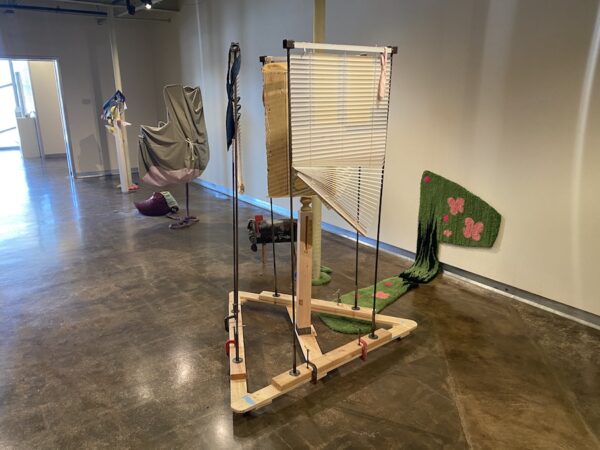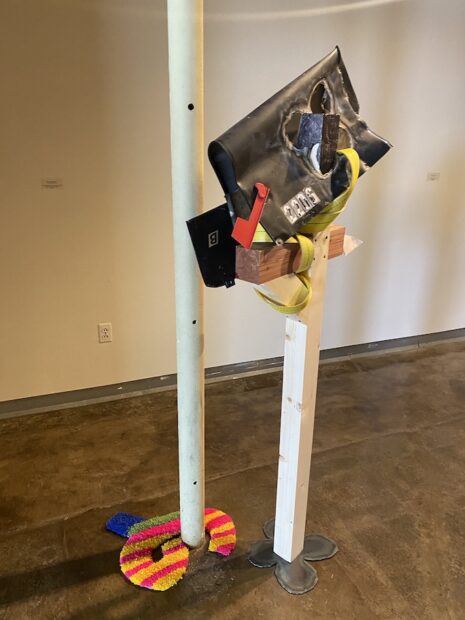
Installation view of AliAnn Rushing Attilio’s solo exhibition “Looking for the dead kind,” at Louise Hopkins Underwood Center for the Arts (LHUCA). Photographs in this story by Hannah Dean.
None of us are alone in fantasizing about what we will do “when the virus is gone.” While we aren’t out of the woods yet, my husband and I have the good fortune to be fully vaccinated and have the mindset of “if not now, when?” when it comes to seeing friends, grandparents, getting tattoos, and the like.
So, from our place in New Mexico, we made a Texas trip to see and do as much as we could. Thankfully Lubbock’s Covid numbers are way down from their winter 2020 peak. Still, most of our usual haunts felt like we were in a ghost town (though driving past some of the strip malls and chain restaurants makes me think that most are going about business as usual). It makes sense that many of the current art offerings touch on themes from the pandemic: physical connection, mundane domesticity, and mental health.
My takes on three notable exhibitions (at separate museum and gallery locations across Lubbock):
1). At the Louise Hopkins Underwood Center for the Arts (LHUCA), AliAnn Rushing Attilio’s solo exhibition dives into everyday domestic themes. Titled Looking for the dead kind, Attilio makes use of laundry baskets, ironing boards, repurposed wood, a garbage pail, mailboxes, chair legs — those of us locked down at home have been staring at such mundane objects for awhile now. I admit I’m reading much pandemic-ness into the work, but even without the living conditions brought on by Covid-19, Attilio’s work gets into the experience of being home all the time for someone like a stay-at-home parent.

Installation view of AliAnn Rushing Attilio’s solo exhibition “Looking for the dead kind,” at Louise Hopkins Underwood Center for the Arts (LHUCA)
It feels poppy — even fun at first glance — but the more I examine the work, the more disturbing it seems. A large pink and very empty word-bubble trash bag is suspended above a small yellow, lidded trash bin. Letters are crammed in mailbox sculptures, on the verge of blowing away in the wind, messages lost (much like the squandered national messaging opportunities of early last year). Attilio’s use of permanent metal support poles in the John F. Lott Gallery works well, with mailbox and mailbox critters encroached upon by saccharine bright, hooked-rug swirls. It brings to mind the Saturday Night Live skit in which Kate McKinnon’s fortuneteller has a vision of her 2019 client yelling in 2020: “Use more soap! I don’t want to get it from a bag of chips!” These works echo feelings of fear about even bringing mail or groceries into the house — fear that death coats their surfaces.
2). This was my first visit to the East Lubbock Art House (ELAH), Lubbock’s newest non-profit gallery founded by Danielle Demetria East. On view for my visit was And Justice For All, an exhibition of daguerreotypes and installations by Lubbock-based artist (and Lubbock County Forensic Case Manager) Jane Lindsay. Her work, based on portraits of individuals that have fallen through the cracks in the mental health and prison systems, is stark both in color and theme (many individuals died by suicide while incarcerated.) The tone of the exhibition reflected many of the missions that East has mentioned in the founding of ELAH — questions of exactly who institutions are there to serve. The mirrored surfaces of Lindsay’s photographs made it impossible to photograph the work, and impossible to escape the implication of one’s self in the MO of institutions — government, justice, citizenry, academia, and the world of art.
3). CO-Opt Research + Projects’ Under Pressure, an exhibition on view (through July 31) through the gallery’s large storefront windows, is an evolving show, with work shifting based on the submissions the collective receives. (Applications are accepted through July 1st, 2021.) Currently two works are on view: A large photograph by Atlanta-based Zachary Francois, and a multi-object and sound installation by Dallas-based Trey Burns. The sound component is available through the gallery’s radio station, 89.9 KOOPT.

CO-Opt Research + Projects’ rotating group exhibition “Under Pressure”: works by Trey Burns (l) and Zachary Francois (r) on view
Both works, especially when viewed in a germ-safe manner, evoke what was lost this last year. The neutral, even resigned expression of the person gazing out at the viewer in Francois’ banner-scale photo mirrors the occasional lackadaisical flutter of the fabric the image is printed on. What the subject’s gaze reflects is the gravity of another’s embrace. Is this an image from a funeral, or other somber gathering? The exhibition materials state that it is a photograph of two friends, but the expression is so heavy, tranquility is the furthest feeling I get from this photograph. The weight carries it.
Burns’ installation, composed of a rock set in a wall stud frame, reads differently. Two bright blue-matted and flamingo-pink-framed photos are set against a yellow wall backdrop. The seated Lily Tomlin collage is nearly gross, Tomlin’s eyes rolled back (or pasted over? It’s hard to tell from far away) as though she has finished her fifth movie marathon this week. In the other photo, a hand seems to reach through a purple wall, gesturing as though tuning a radio knob. The radio component of this work (I listened to ten minutes or so) seems like white noise. It reminds me of the bleak, endless stream of content I consume, which at the beginning of the pandemic was a godsend, and now seems like a curse.
I wonder if the unfinished studs framing out the wall on which one photo is displayed is part of the gallery space, or part of the installation. Either way, it feels like the bones of things. Maybe basic needs, like belonging and autonomy. Or the maybe remains of our politics that have been demolished — still there but very raw.
As I viewed the show, I swelled with sorrow for those who didn’t make it to the “other side,” or even know there was one. I swell with sorrow — a grief for that which didn’t exist for too long, and worry for what the hell might come next.



